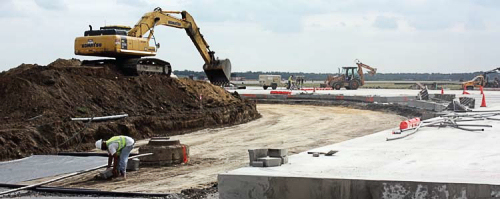Detroit Metro Uses Stimulus Funds for Runway Reconstruction

 |
 |
Wayne County Airport Authority (WCAA) officials felt it didn't make sense to repair the runway then since reconstruction was to begin in the summer. "We had already eked out five years more than anyone would have expected," says WCAA project manager Steve Wiesner.
When American Recovery Reinvestment Act (ARRA) funds became available in the spring, WCAA was awarded a $15 million grant for the $34 million project. It consequently compressed the previous two-year runway reconstruction project into a single season and scheduled associated taxiway work for completion in 2010.
|
Steve Wiesner |
"I'm sure the support we received from our legislative contingent in Washington, D.C., particularly Congressman John Dingle, played an important role in our receiving such a generous grant," notes WCAA public affairs manager Scott Wintner.
120 Days & Counting
Once stimulus funds became available, the project moved quickly. Construction crews broke ground in late June for a complete rebuild of the 8,700-foot runway that included storm drainage, electrical/lighting and signage. The southern half of 8,500-foot long runway 3L/21R was also rehabilitated - all within with same 120-day timeframe.
|
Facts & Figures Project: Runway Reconstruction & Rehab Location: Detroit Metropolitan Wayne County Airport Timeline: June to October 2009 Approximate Cost: $62 million Funding: $15 million ARRA Stimulus Grant and various matching grants Prime Contractor: Ajax Paving Industries Engineering, Design and Construction Management: AECOM Design/Engineering Consultant: C & S Companies Excavation: Dan's Excavating Electrical: Rauhorn Electrical Airfield Lighting: ADB Airfield Solutions Synthetic Surface: AvTurf |
The tight timeframe for completion also made the project a "monumental task" for Ajax Paving Industries, which served as the prime contractor and performed the concrete and asphalt work.
"To have over 200 people working 24 hours a day on a project of this magnitude with no incidents or incursions is pretty incredible," says Ajax project manager Yvonne Kur.
Intermediate timelines within the 120-day window helped maintain airport traffic, notes Kur. Precise scheduling and timely on-site delivery of materials were also key.
Airfield layout and the interrelated nature of its runways further complicated matters. Runway 9L/27R, one of DTW's two crosswind runways utilized when the west winds are strong, intersects three major runways. Because 3L/21R had to be shutdown for rehabilitation work, the airport could not afford to shutdown any other runways throughout the project. Such constraints created access challenges for construction crews. Multiple entry points around the airfield and an additional service drive were constructed to help contractors enter the worksite.
|
Jim Kirschbaum |
Going Green
To maximize the lifespan of the new 150-foot-wide, 18-inch-thick concrete runway, the airport authority chose to construct it at 100% frost-depth protection, as opposed to the 60% Federal Aviation Administration (FAA) minimum. With 60% depth protection, life expectancy is approximately 20 years. WCAA hopes to get an additional 10 years with its extra depth.
Deeper excavation, however, required additional aggregate fill. To make up the difference, the old runway was removed and crushed to consistent specification of gradation with an on-site crusher. The recycled runway was used as base materials for the new concrete runway and adjacent 30-foot-wide asphalt shoulders.
|
Rick Kincaid |
Crews milled off the asphalt; concrete was broken, then removed.
"Where you had bituminous over concrete, the asphalt tended to act as a sponge, and you had to hit it harder," notes Kincaid.
Aggregate density for the project was specified at 100%. Because recycled materials came from several different eras and contained different concrete materials, obtaining the full density was more challenging than usual.
"We could get to 98% density with relatively consistent effort," Kincaid recalls, "but the last 2% was at times a struggle. Moisture control was very important and required a lot of trial and error."
Recycled materials were tested extensively before being placed in two separate six-inch lifts, each of which was compressed to 100% compaction.
"It's a challenge trying to compact materials that are not consistent," Kur adds. "You're not sure how many times you have to roll so constant density checks were required."

Runway or Taxiway?
When installing the new runway lights, the airport chose a system from ADB Airfield Solution that allows the runway to be switched to a taxiway with the flip of a switch by air traffic control. In runway mode, the system automatically displays the appropriate stop bars on the crossing taxiways. When flipped to taxiway mode, the stop bars are turned off and others are turned on where the taxiway crosses the parallel runways.
"This unique system gives us a lot of flexibility," says Wiesner. "If we need to do maintenance on the parallel taxiway, we can shut it down and meet all the requirements for using our crosswind runway as a taxiway."
Rippling Effects
ARRA stimulus funds and DTW's runway projects couldn't have come at a better time for Detroit, an area hit particularly hard by the current economic crisis. Wiesner estimates that 255 area jobs were retained for the construction project, with 65 of them created by stimulus funding.
The dramatically compressed timeline for the projects also provided benefits. If the crosswind runway had shut down for two seasons as originally planned, airlines would have spent more time taxiing around the airfield, which increases fuel consumption and affects arrival/departure schedules.
Wiesner estimates the abbreviated project schedule cut fuel consumption and aircraft emissions in half.
FREE Whitepaper
PAVIX: Proven Winner for All Airport Concrete Infrastructure
International Chem-Crete Corporation (ICC) manufactures and sells PAVIX, a unique line of crystalline waterproofing products that penetrate into the surface of cured concrete to fill and seal pores and capillary voids, creating a long lasting protective zone within the concrete substrate.
Once concrete is treated, water is prevented from penetrating through this protective zone and causing associated damage, such as freeze-thaw cracking, reinforcing steel corrosion, chloride ion penetration, and ASR related cracking.
This white paper discusses how the PAVIX CCC100 technology works and its applications.











